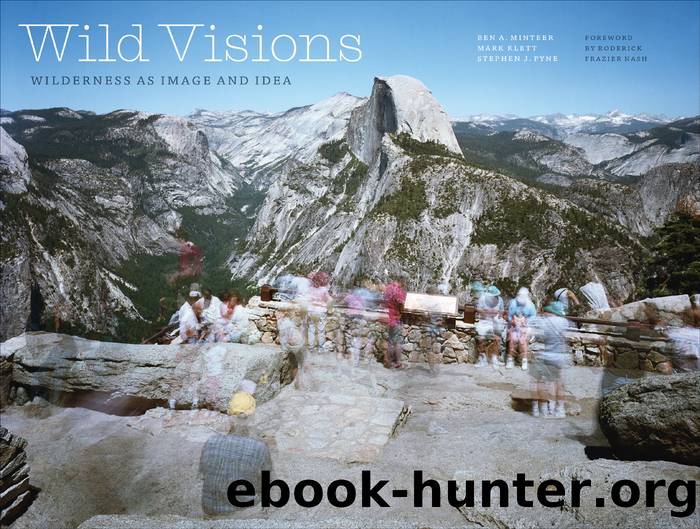Wild Visions by Ben A Minteer

Author:Ben A Minteer
Language: eng
Format: epub
Publisher: Yale University Press
Published: 2022-01-15T00:00:00+00:00
48. Len Jenshel, Rt 127, near Death Valley National Monument, California, 1990
49. Joshua Haunschild, Rock Springs, Wyoming, 2015
In Desert Cabal: A New Season in the Wilderness, author and public lands activist Amy Irvine writes (with clear ambivalence), âDesert Solitaire framed the American Westâ through Abbeyâs lens, creating a set of aesthetic and experiential expectations about the âred raw desertâ that would exert considerable power over generations of readers.12 Yet despite the highly visual character of Abbeyâs writing, he apparently didnât think much of landscape photography as a catalyst for environmental ethics. âAs I say to my friends Eliot Porter, Ansel Adams, and Philip Hyde, one word is worth a thousand pictures,â Abbey snickered. But he offered an immediate qualification: âIf itâs the right word.â13 This being Abbey, though, his relationship to photography was a little more complex than that.
In fact, Abbey published a series of major photographic books in the 1970s following the success of Desert Solitaire, both for the Time Life American Wilderness Series and the Sierra Club, working with photographer heavyweights like Porter and Hyde. But he was apparently somewhat bitter about the booksâ failure to generate the response of some of his other work. Abbey felt that the pictures tended to overshadow his prose and would later refer to them as his âtrashy little picture books.â (For the record, theyâre actually quite appealing publications. Some of this has to do with Abbeyâs tone, which is generally more tempered than in many of the essays he wrote after The Monkey Wrench Gangâand when the Cactus Ed persona was in full bloom.)
Abbey understood that the aesthetics of wilderness preservation often rested on romanticized, and thus partial, images: the photographic iconography of the wild sublime. But he also knew that these images were at the same time idealizations, artistic inventions.
We can see evidence of Abbeyâs more nuanced view on this question in an essay he wrote describing a return visit to Yosemite National Park in 1970 (collected in his book The Journey Home). During his trip, Abbey ends up at the parkâs most iconic vantage point. âSomewhere near Cascade Creek,â he writes, âwe stopped at a turnout for the classic view of Yosemite Valley, as invented by Ansel Adams [emphasis added]. There was El Capitan, Half Dome, Sentinel Dome, Bridalveil Falls.â14
But he also noticed something else, something that altered the classic Adams image. There was, he observed, âa blue haze above the valley floor.â
Was it woodsmoke, he wondered? Or was it exhaust fumes?
âThe Secret of the Green Maskâ appeared in print in March 1989, the month and year of Abbeyâs death. It remains a little-known piece and hasnât to my knowledge been reprinted. Still, itâs a nice example of the authorâs easy hand with the immersive travel essay and a reminder that Abbey didnât always carry a rhetorical blowtorch when he wrote passionately about a wild place that meant something to him.
And it turns out thereâs one more secret buried in Abbeyâs Grand Gulch piece, one that also hinges on a key image from the trip.
Download
This site does not store any files on its server. We only index and link to content provided by other sites. Please contact the content providers to delete copyright contents if any and email us, we'll remove relevant links or contents immediately.
| Gardens | Landscapes |
| Plants & Animals | Underwater |
Shoot Sexy by Ryan Armbrust(17653)
Portrait Mastery in Black & White: Learn the Signature Style of a Legendary Photographer by Tim Kelly(16949)
Adobe Camera Raw For Digital Photographers Only by Rob Sheppard(16897)
Photographically Speaking: A Deeper Look at Creating Stronger Images (Eva Spring's Library) by David duChemin(16618)
Bombshells: Glamour Girls of a Lifetime by Sullivan Steve(13970)
Art Nude Photography Explained: How to Photograph and Understand Great Art Nude Images by Simon Walden(12974)
Perfect Rhythm by Jae(5322)
Pillow Thoughts by Courtney Peppernell(4207)
The Book of Joy by Dalai Lama(3897)
Good by S. Walden(3484)
The Pixar Touch by David A. Price(3361)
A Dictionary of Sociology by Unknown(3013)
Fantastic Beasts: The Crimes of Grindelwald by J. K. Rowling(2994)
Humans of New York by Brandon Stanton(2833)
Stacked Decks by The Rotenberg Collection(2808)
Read This If You Want to Take Great Photographs by Carroll Henry(2661)
On Photography by Susan Sontag(2574)
Insomniac City by Bill Hayes(2493)
Photographic Guide to the Birds of Indonesia by Strange Morten;(2489)
